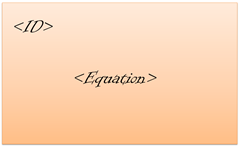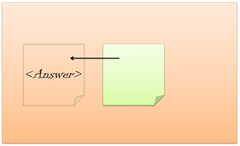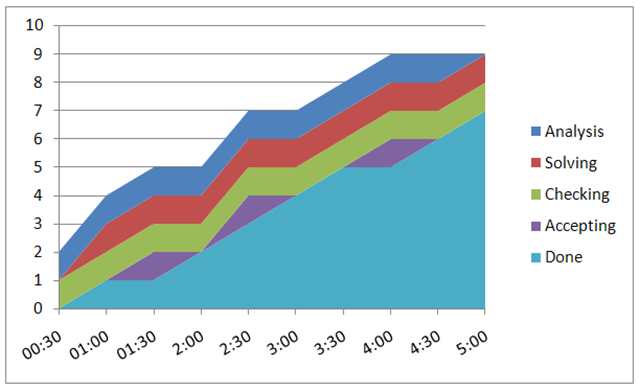I put together a small simulation for the SPA Conference this year which seemed to go well, and which I re-ran at the London Limited WIP Society, and hope to run again. You can download the materials, and this is a short write-up of how it works so people can run it and experiment with it themselves.
Overview
The basic aim of the simulation is to solve maths problems. This idea was inspired by Simon Bennett and Mark Summers session The Incentive Trap which also uses maths as the problem domain. The solving of equations introduces variability into the exercise using some simple knowledge work which is hopefully more interesting and engaging than rolling dice.
The maths problems flow through the following value stream:
-
Options
-
Analysis
-
Solve
-
Check
-
Accepts
-
Done
The following roles are involved in the value stream:
-
Analyst
-
Solver
-
Checker
-
Accepter
-
Manager
The following scenarios are used to experiment with the flow:
-
Phase Driven
-
Time Boxed
-
Flow Based
Stages
Options
Each scenario starts with a portfolio of possible problems to solve, in the following format:
| ID | Operands | Solution |
| 1 | 3 | 25 |
In this example we have an option to create an equation with 3 operands and a solution of 25.
Analysis
When an option is selected, it is transformed into an equation during analysis. Rather than expecting participants to come up with their own equations, which could result in trivial equations, a lookup is provided. The equations in the lookup are in a different order to those in the portfolio so some effort is required!
| Operands | Solution | Equation |
| 3 | 25 | 3 * 7 + 4 |
Solve
The equations are then solved independently i.e. the solution is not available
Check
In order to check that the Solve stage produces a correct result, the equation is solved independently again.
Accept
Finally the two independent solutions are compared, along with the actual equation, to ensure it has been solved correctly
| ID | Operands | Solution | Equation |
| 1 | 3 | 25 | 3 * 7 + 4 |
Done
When the correct equation has been independently solved correctly twice, then the problem can be considered Done.
Roles
Analyst
The analyst selects the options from the portfolio, matches them against the available equations, and writes them onto index cards. Each index card should contain the option ID and the equation as follows:
Solver
The solver takes each index card with an equation on it, and solves it. Any intermediate calculations should be written on a separate sheet, and calculators should not be used (although someone who did use a calculator at SPA didn’t seem to gain any advantage!) The answer is to be written on the back of the back of the index card, to the left side, and covered with a small post-it so that is hidden and can’t be copied.
Checker
The checker also takes each index card with an equation on it, and solves it. Again, any intermediate calculations should be written on a separate sheet, and calculators should not be used. this time, the answer is to be written on the back of the back of the index card, to the right side, and again covered with a small post-it so that is hidden.
Accepter
The accepter takes the index card and confirms whether the ID and equation match correctly, and that the two answers are both the same and correct. The they are, the the problem is Done, otherwise they reject it. Each scenario will handle rejection differently.
Manager
The managers job is to keep time, ensure the process is being followed and capture metrics. Every 30 seconds they should count how many of the maths problems are in each stage of the value stream and record it on a worksheet. It is these numbers which can be fed into a spreadsheet to generate a Cumulative Flow Diagram to visualise the flow.
Scenarios
Each scenario is 5 minutes each.
Phase Driven
For a phase driven approach, the team should initially plan how many of the set of options they think that they can complete in the 5 minutes available. Then all the selected options are worked on phase by phase. Thus they are all analysed, then all handed over to be solved, then all handed over to be checked, and finally all handed over to be accepted. Any rejected work can only be moved back to the beginning once everything else has been accepted as Done.
Time Boxed
For the time boxed approach, the team should plan how many of the set of options they think that they can complete in the 1st of the 5 minutes. Those options are then worked on by the team individually. Specialism still applies, but once a problem has been analysed, it can move to be solved, check and analysed without waiting for the whole batch. At the end of the 1 minute time-box, the team should stop, review and re-plan the next minute, deciding how many problems to work on next. This is repeated until the 5 minutes are up i.e. there are 5 x 1 minutes time boxes. Any rejected work can be passed back immediately.
Flow Based
For the flow based approach, the team should pick 1 problem at a time to solve. As with the time boxed scenario, specialism still applies, so once a problem has been analysed, it can move to be solved, check and analysed. However, there should only be one problem in each stage of the value stream at a time, thus creating a pull system. Any rejected work can be passed back immediately (which may result in the WIP limits being broken), or the accepter can pull in the appropriate role to resolve the issue.
Results
The metrics from the managers worksheets can be fed into an excel spreadsheet (included in the download package) to generate CFD diagrams. Here are 3 from one of the teams at SPA.
Phase Driven
Time Boxed
Flow Based
Variations
There are a number of variations I’d like to try.
- One of the things I’ve noticed is that the maths problems may be just a little bit too difficult for some teams, and the take too long sometimes to get any really useful results. One option would be to extend the time for each scenario to 10 minutes to allow more time. I wonder whether this could make it less snappy though.
- The time-boxed scenario never really plays out how I envisaged it. This is partly down to the short time frames. Stopping, reviewing and replanning every minute doesn’t seem right – especially when you can only manage 1 problem in a minute! What i was trying to show was the small-batching nature a time-box can have. One way round this is to explicitly create the batches in a similar way to the Penny Game.
- Some people don’t like the mental exercise involved in the maths! Katherine Kirk described a variation to me where the teams used a “Pictionary” workflow instead. Options –> Describing –> Drawing –> Guessing –> Checking –> Done
- Its quite likely that the Flow scenario comes out “best” because its the last one. It would be interesting to run the scenarios in different orders to see what impact that had. Especially if there are 3 or more teams so that each team can start with a different scenario. This would possibly be more complicated to run, but with enough facilitation could be done.
Feel free to download the pack, which contains:
- Handouts – PDFs of the options, analysis and accepter worksheets for each scenario
- Spreadsheets – one with all the details used to create the worksheets, and one to be used to create the CFDs
- Powerpoint – slides with simple instructions for running the experiment
All I ask is that you let me know how you got on, and what variations you come up with. Here are the SPA results and LWS results.








Thanks a lot for sharing these materials Karl. If I have time, I’ll blog in detail about my experience of running this session with a team earlier this week.
One thing I noticed was that as I was explaining the process, they were trying it out for themselves, and naturally used a flow style. When I then imposed the rules for the phase-based approach and they started to do it, lightbulbs went on all over the room: “Why on earth would you want to run a project like this?”
Great stuff.
[…] The Flow Experiment (Karl Scotland) […]